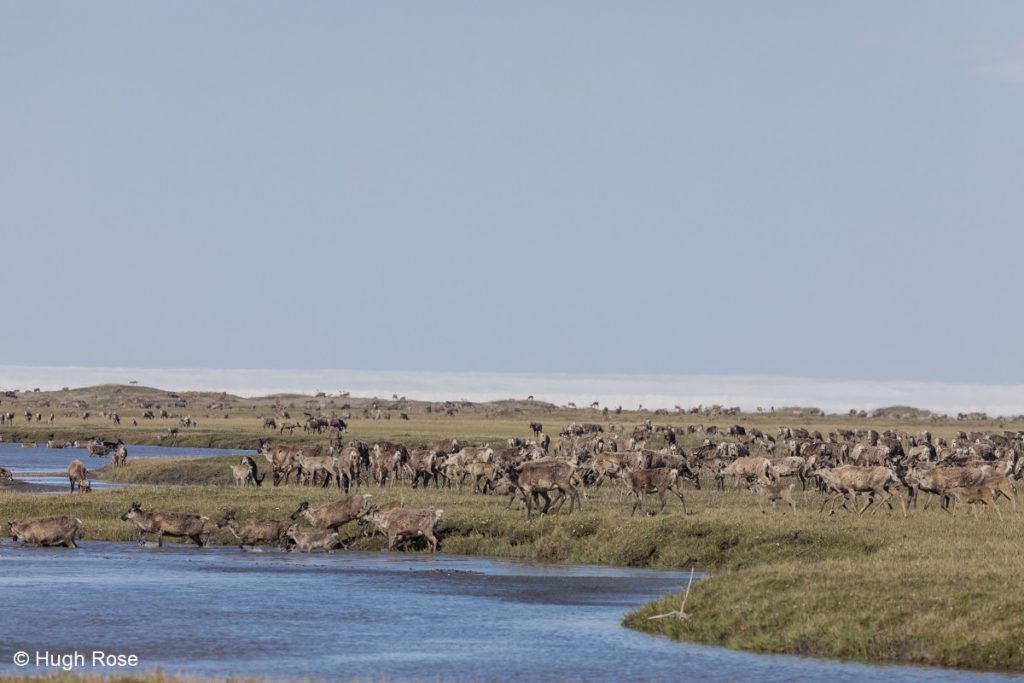It’s Congress’ turn to stop Arctic Refuge oil drilling

The time is now for Congress to repeal the 2017 Arctic Refuge oil leasing mandate and open the door once again to permanent protection.
This piece originally ran in The Hill. Cover photo: Porcupine caribou on the Arctic Refuge coastal plain. (Hugh Rose)
By: Finis Dunaway
In the beginning of June, the Biden administration took another important step to keep oil drills out of the Arctic National Wildlife Refuge. The order, issued by Secretary of the Interior Deb Haaland, suspended all fossil fuel leases auctioned off by the Trump administration on Jan. 6, pending a further environmental review. Haaland’s directive extends the force of President Biden’s executive order, signed on his first day in office, that placed a temporary pause on development activities in the Arctic Refuge. But the fate of this place remains uncertain.
Four decades ago, a legislative compromise set in motion the battle over the Arctic Refuge that has ensued ever since. The fact that this land has not become another Prudhoe Bay, filled with sprawling spiderwebs of fossil fuel infrastructure, is a testament to the power of diverse alliances and grassroots activism. Without the involvement of countless people across the continent, the refuge would have long ago been turned into an oil field. Without Congressional action, it may still become one.
Defenders of the refuge knew from the start that they were up against powerful, deep-pocketed adversaries including the oil industry, the state of Alaska and pro-drilling politicians. The only way to win, they believed, was to adopt a strategy that some activists called the “trickle-up theory of politics.” According to this theory, the defenders sought to bring local, grassroots attention to the Arctic Refuge in communities across the United States. In turn, they believed, local media coverage and citizen concern would trickle up to national media outlets and policymakers in Washington.
Until 2017, the trickle-up approach worked. More than any other factor, citizen involvement made all the difference, encouraging fence-sitting politicians to cast their vote in favor of refuge protection. In the pre-social media era, refuge defenders used outreach strategies that no doubt seem quaint today: traveling slide shows, film screening parties and other events to galvanize concern and encourage action. These events, which took place in such modest venues like libraries, schools and church basements, encapsulated the democratic vision underlying the refuge campaign. Activists believed that the voices of ordinary people mattered and that their letter-writing, phone calls and other actions could influence decision-making on Capitol Hill.
What made the trickle-up campaign so effective was the involvement of diverse groups. If the fight had remained narrowly focused on wilderness versus oil, it is almost certain that refuge defenders would have lost long ago. In particular, the Gwich’in Steering Committee — founded by Gwich’in from Alaska and Canada in 1988 — reframed public perceptions of the refuge, helping grassroots audiences to see the Arctic coastal plain as vital to Indigenous food security and cultural survival. Their leadership and advocacy widened support for protection of the refuge, encouraging religious and faith organizations, human rights groups and many others to fight for Indigenous rights and environmental justice. These unlikely alliances fostered grassroots involvement that proved critical to the numerous close calls and impossibly narrow victories that followed. In many cases, moderate Republicans cast decisive votes, demonstrating the long tradition of bipartisan support for the refuge.
And then came the election of Donald Trump. By that time, the Republican Party had become so radicalized, so overwhelmingly dominated by climate-change denial and anti-democratic views, that the trickle-up strategy finally failed. The voices of ordinary people, the polls indicating vast majorities of Americans opposed to drilling, the urgent need to protect wildlife habitats and Arctic ecosystems, the evidence gathered by government scientists, the rights of Indigenous peoples, all were trampled over by passage through reconciliation of the Tax Cuts and Jobs Act of 2017, which included a provision mandating oil and gas lease sales in the Arctic Refuge.
The first lease sale, held on Jan. 6, just as insurrectionists were storming the Capitol, has widely been described as a bust, with no major oil companies placing any bids. The lackluster sale resulted not just from falling oil prices and a pandemic-induced global recession, but because of banking and corporate campaigns led by the Gwich’in alongside their Iñupiat and environmental allies that made many industry leaders deem Arctic drilling a bad investment.
Nevertheless, about 500,000 acres of the coastal plain have been leased, and if the tax act’s drilling provision is not overturned, the Arctic Refuge could still become an industrialized oil field.
2021 represents a pivotal moment for the refuge fight. The time is now for Congress to repeal the 2017 Arctic Refuge oil leasing mandate and open the door once again to permanent protection. And if Congress ever does designate permanent protection, it will be because of the long history of unlikely alliances and grassroots participation, and the countless people from across the country that became involved in a cause larger than themselves, a fight to keep the Arctic Refuge free from oil development. All along, it has also been a fight to show that the voices of the people matter, to maintain faith in democracy despite the powerful interests arrayed against it.
Finis Dunaway is a professor of history at Trent University and author of “Defending the Arctic Refuge: A Photographer, an Indigenous Nation, and a Fight for Environmental Justice.” Follow him on Twitter @FinisDunaway.
The views expressed here are the writer’s and are not necessarily endorsed by Alaska Wilderness League.
